
Kudzu Jelly - How to make and can kudzu Jelly
How to Make Kudzu
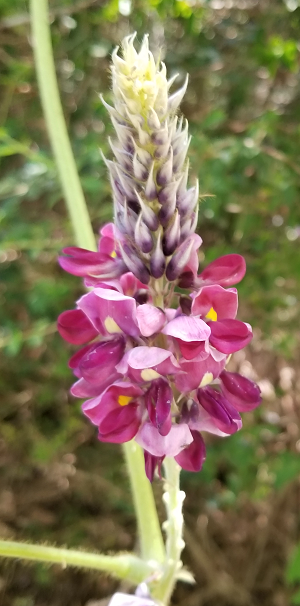 Jelly
Jelly
Yes, you can make a tasty jelly from kudzu flowers. The
closest description of the flavor is that it tastes similar to
raspberry jelly. And making and canning your own kudzu jelly is quite easy
and inexpensive.
Here's how to do it, in easy steps and completely illustrated.
For easy other easy, illustrated jam, jelly, and other canning directions, like applesauce or apple butter directions, click on these links.
Ingredients
- Kudzu blossoms - At least 4 cups of kudzu blossoms. I prefer to do 6 cup batches. See step 1 for details.
- Pectin - 1 and a half packages (box usually) or if you get it in bulk, 6 Tablespoons, see the directions below for specifics - (it's a natural product, made from apples and available at grocery stores (season - spring through late summer) and local "big box" stores. It usually goes for about $2.00 to $2.50 per box. You will get best results with no-sugar needed pectin, whether you choose to add sugar or not! See here for more information about how to choose the type of pectin to use.
- Sugar - About 5 cups of dry, granulated (table) sugar, if you use the no-sugar-needed pectin (the only type I recommend) or low sugar pectin. If you use regular pectin, you will need 7 cups of sugar. Of course, you can substitute honey, agave, stevia or Splenda; just be sure to use the no-sugar needed type of pectin. See this page for more information about pectin and where to get it.
- Lemon juice - 1/4 cup, preferably bottled, for the consistency of the pH
Equipment
- Large spoons and ladles,
- Jar funnel ($5 at Target, other big box stores, and often grocery stores; and available online - see this page) or order it as part of the kit with the Jar grabber .
- Jar grabber (to pick up the hot jars)- Big box stores and grocery stores sometimes carry them; and it is available online - see this page. It's a tremendously useful to put jars in the canner and take the hot jars out (without scalding yourself!). The kit sold below has everything you need, and at a pretty good price:
- At least 1 large pot; I prefer 16 to 20 quart Nonstick ceramic coated pots for easy cleanup.
- 1 Water Bath Canner (a huge pot to sanitize the jars after filling (about $30 to $35 at mall kitchen stores, sometimes at big box stores and grocery stores.). Note: we sell canners and supplies here, too - at excellent prices - and it helps support this web site!
- Half pint canning jars (Grocery stores, like Publix, Kroger, Safeway carry them, as do some big box stores - about $7 per dozen 8 ounce jars including the lids and rings)
- Lids - thin, flat, round metal lids with a gum binder that seals them against the top of the jar. They may only be used once.
- Rings - metal bands that secure the lids to the jars. They may be reused many times.
Optional stuff:
- Lid lifter (has a magnet to pick the lids out of the almost-boiling water where you sanitize them. ($4 at big box stores or it comes in the kit at left)
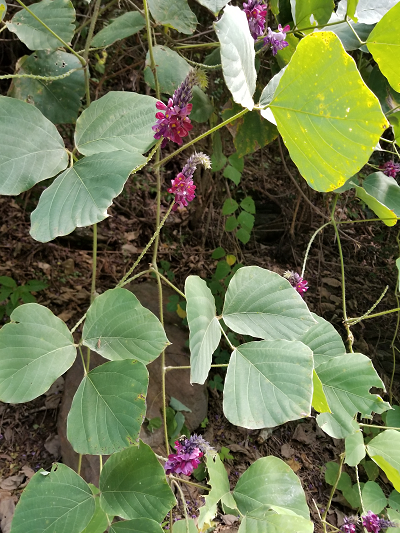 Kudzu jelly-making Directions
Kudzu jelly-making Directions
This example shows you how to make kudzu jelly. You can use this recipe to make almost any type of jelly from the fruit juice; where there is a difference, I will point it out! The yield from this recipe is about 12 eight-ounce jars (which is the same as 6 pints).
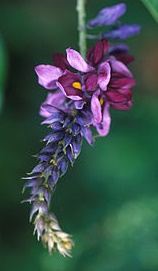 Step
1 - Pick the kudzu blossoms!
Step
1 - Pick the kudzu blossoms!
It's easy to find and pick kudzu blossoms. Kudzu is a weed, originally brought here from Asia, which grows al over the South of the US. It is an annual weed that grows at a phenomenal rate. Goats are often used to eat it and control it. I go to any City, State or National park or wildlife area to find it. That way, you don't need to worry about pesticides or contaminants. Kudzu blooms from July through September. I find most in August.
You only need the individual open flowers, not the closed buds, so you simply grasp the purple flow stalk with your hand and gently pull them off. You will need to collect at least 6 cups of flowers to make a batch of jelly.
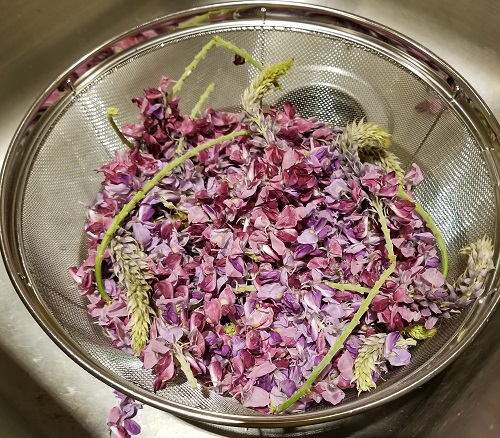 Step 2 - How many
flowers to pick?
Step 2 - How many
flowers to pick?
kudzu jelly can ONLY be made in rather small batches - about 4 to 6 cups at a time - like the directions on the pectin say, DO NOT increase the recipes or the kudzu jelly won't "set" (jell, thicken).
So that means you will want to pick 4 to 6 cups amounts of kudzu flowers. Basically if you loosely fill a grocery store plastic bag, that's about 6 cups, after you remove the stems and unopened blooms.
Step 3 - Wash the jars and lids
Now's a good time to get the jars ready, so you won't be rushed later. The dishwasher is fine for the jars; especially if it has a "sanitize" cycle, the water bath processing will sanitize them as well as the contents! If you don't have a dishwasher with a sanitize cycle, you can wash the containers in hot, soapy water and rinse, then sanitize the jars by boiling them 10 minutes, and keep the jars in hot water until they are used.
 NOTE: If a canning recipe calls for 10 minutes or more of process time in the canner, then the jars do not need to be "sanitized" before filling them.
But really, sanitizing them first is just good hygeine and common sense! See this page for more detail about cleaning and sanitizing jars and lids.
NOTE: If a canning recipe calls for 10 minutes or more of process time in the canner, then the jars do not need to be "sanitized" before filling them.
But really, sanitizing them first is just good hygeine and common sense! See this page for more detail about cleaning and sanitizing jars and lids.
Instead of the above, you can also put the jars in the boiling water in the canner for 5 minutes before you fill them - this is the best method!
Put the lids into a pan of hot, but not quite boiling water (that's what the manufacturer's recommend) for 10 minutes, and use the magnetic "lid lifter wand" to pull them out.
Leave the jars in the dishwasher on "heated dry" until you are ready to use them. Keeping them hot will prevent the jars from breaking when you fill them with the hot jelly.
Step
4 -Clean and wash the kudzu blossoms!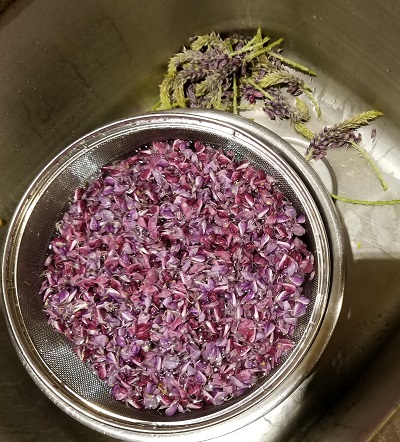
First pick out any brown or dead flowers, bugs, stems and other debris. Then rinse gently under cold water.
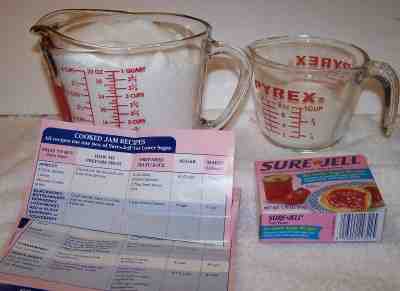 Step
5 - Measure out the sugar
Step
5 - Measure out the sugar
If you use the regular pectin it takes 7 cups of sugar to 5 or 6 cups of juice and one and a half boxes (5 or 6 Tablespoons) of regular pectin. You can use only 5 cups of sugar if you use the "no-sugar-needed" pectin. . Mix the dry pectin with about 1/4 cup of the sugar and keep this separate from the rest of the sugar. If you are not using sugar, you will just have to stir more vigorously to prevent the pectin from clumping.
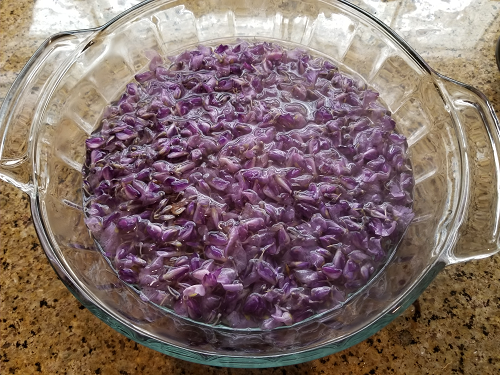 Step
6 - Boil 5 cups of water and steep the flowers
Step
6 - Boil 5 cups of water and steep the flowers
Now get 5 or 6 cups of water boiling (1 cup of boiling water per cup of flowers). Then pour it over the Kudzu flowers in either a Pyrex glass container or a Teflon or ceramic lined metal container. No bare metal! Now, we let it steep or soak for at least 8 hours or overnight.
S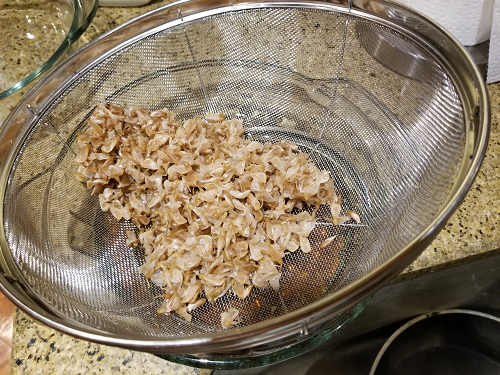 tep
7 - Strain the steeped "Kudzu Tea"
tep
7 - Strain the steeped "Kudzu Tea"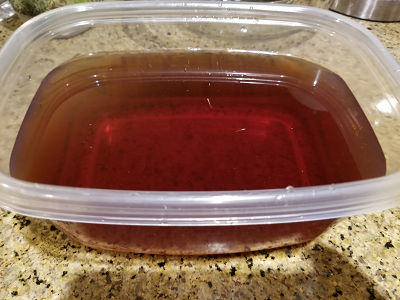
Just pour the steep kudzu flowers through a strainer, sieve or jelly strainer.
Step 8 - Put the kudzu tea in a large pot, add lemon juice and pectin
Discard the flowers and Put the kudzu extract6 or tea in a big pot on the stove.
Add the pectin from step 5 (mixed with 1/4 cup of the sugar). Stir well.
Now add the 1/4 cup of lemon juice.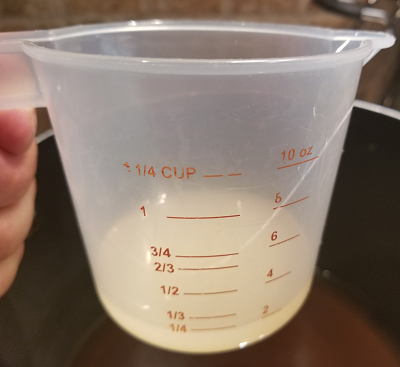
Step 9 - Bring to a full boil
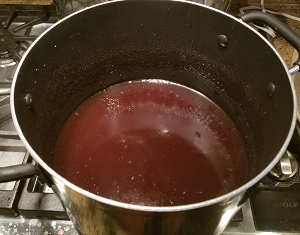 Heat
the pot on
the stove over medium to high heat (stir often enough to prevent burning).
It should take about 5 to 10 minutes to get it to a full boil (the kind
that cannot be stirred away).
Heat
the pot on
the stove over medium to high heat (stir often enough to prevent burning).
It should take about 5 to 10 minutes to get it to a full boil (the kind
that cannot be stirred away).
Notes about pectin: I usually add about 25% - 30% more pectin (just open another pack and add a little) or else the jelly is runnier than I like. With a little practice, you will find out exactly how much pectin to get the thickness you like.
Another tip: use the low sugar or no-sugar pectin. It cuts the amount of sugar you need from 7 cups per batch to 4 cups. And it tastes even better! On the other hand; I still add some sugar, even with the No-sugar pectin. With no added sugar, the batches always turned out runny and bland. You might want to try using the low sugar recipe with a mixture of sugar and Stevia (or if you prefer, agave, honey or Splenda); that could work, but you do get the best results with sugar.

Is your jelly too runny? Pectin enables you to turn out perfectly set jelly
every time. Made from natural apples, there are also natural no-sugar
pectins that allow you to reduce the sugar you add by half or even eliminate
sugar.!
Get them all here at the best prices on the internet!


Step 10 - Get the lids warming in hot (but not boiling) water
If you didn't do so already, put the lids into a pan of hot water for at least several minutes; to soften up the gummed surface and clean the lids.
Need lids, rings and replacement jars?
Get them all here, delivered direct to your home, at the best prices on the internet!
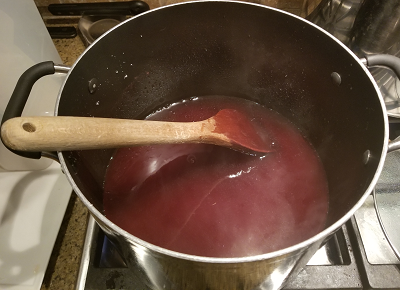 Step 11 -
When boiling, add the remaining sugar and bring back to a boil
Step 11 -
When boiling, add the remaining sugar and bring back to a boil
When the kudzu-pectin mix has reached a full boil, add the rest of the sugar (about 4.5 cups of sugar per 5 or 6 cup batch of kudzu extract 4 and then bring it back to a boil and then boil hard for 1 minute, stirring constantly
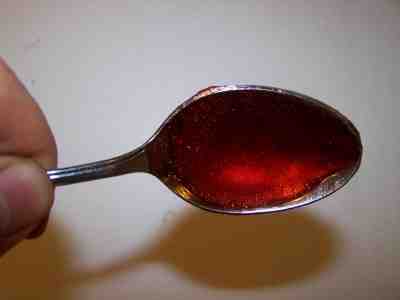 Step
12 - Testing for "jell" (thickness)
Step
12 - Testing for "jell" (thickness)
I keep a metal tablespoon sitting in a glass of ice water, then take a half spoonful of the mix and let it cool to room temperature on the spoon. If it thickens up to the consistency I like, then I know the jelly is ready. If not, I mix in a little more pectin (about 1/4 to 1/2 of another package) and bring it to a boil again for 1 minute.
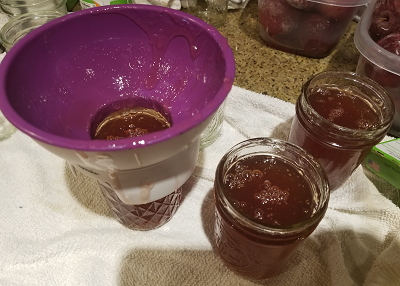 Step
13 - Fill the jars and put the lid and rings on
Step
13 - Fill the jars and put the lid and rings on
Fill them to within 1/4-inch of the top, wipe any spilled jelly off the top, seat the lid and tighten the ring around them. Do not tightenn hard; just 1/4 turn past when it seats; just snug so they don't leak, Then put the filled jars into the canner!
This is where the jar tongs come in really handy!
Step 14 - Process the jars in the boiling water bath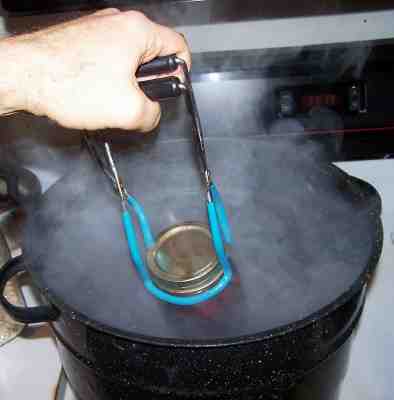
Keep the jars covered with at least 2 inches of water. Keep the water boiling. In general, boil them for 5 minutes, which is what SureJell (the makers of the pectin) recommend. I say "in general" because you have to process (boil) them longer at higher altitudes than sea level, or if you use larger jars, or if you did not sanitize the jars and lids right before using them. The directions inside every box of pectin will tell you exactly - and see the Table below for altitude differences. The directions on the pectin tend to be pretty conservative. Note: Some people don't even boil the jars; they just ladle it hot into hot jars, put the lids and rings on and invert them, but putting the jars in the boiling water bath REALLY helps to reduce spoilage! To me, it makes little sense to put all the working into making the jelly and then not to process the jars to be sure they don't spoil!
| Table 1. Recommended process time for kudzu jelly in a boiling water canner. | ||||
| Process Time at Altitudes of | ||||
| Style of Pack | Jar Size | 0 - 1,000 ft | 1,001 - 6,000 ft | Above 6,000 ft |
| Hot | Half-pints or Pints |
5 min | 10 | 15 |
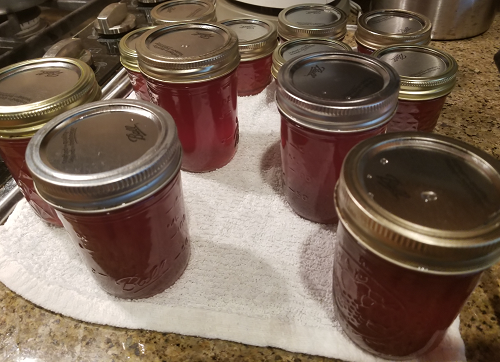 Step
15 - Remove and allow the jars to cool - Done!
Step
15 - Remove and allow the jars to cool - Done!
Lift the jars out of the water with your jar lifter tongs and let them cool without touching or bumping them in a draft-free place (usually takes overnight) You can then remove the rings if you like, but if you leave them on, at least loosen them quite a bit, so they don't rust in place due to trapped moisture. Once the jars are cool, you can check that they are sealed verifying that the lid has been sucked down. Just press in the center, gently, with your finger. If it pops up and down (often making a popping sound), it is not sealed. If you put the jar in the refrigerator right away, you can still use it. Some people replace the lid and reprocess the jar, then that's a bit iffy. If you heat the contents back up, re-jar them (with a new lid) and the full time in the canner, it's usually ok.
Once cooled, they're ready to store. I find they last up to 12 months. But after about 6 to 8 months, they get darker in color and start to get runny. They still are safe to eat, but the flavor and texture aren't as good. So eat them in the first 6 months after you prepare them!
Other Equipment:
- Jar lifting tongs to pick up hot jars
- Lid lifter - to remove lids from the pot of boiling water (sterilizing )
- Lids- disposable - you may only use them once
- Ring - holds the lids on the jar until after the jars cool - then you remove them, save them and reuse them
- Canning Jar funnel - to fill the jars
Frequently Asked Questions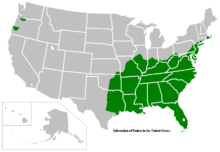
Q. I was reading the instructions on making kudzu jelly. Where do you find Kudzu?
A.Kudzu is an invasive plant species, not native to the U.S., but it has taken over much of the southeast and some of the coastal northwest, see the map:
Comments and tips
- Comments from a visitor on August 29, 2017: "I used your instructions to make my first batch of kudzu jelly.. I've never made jelly of any type before and I got brave and attempted it..:D It worked out fabulously and I wanted to say Thank you for your great instructions.. :D Now I am making my third batch after my family and friends loved it so much!! :D
Other related information
Notes for August 2025: Spring is here! Strawberry season is here. It started in February in Florida, Texas, southern California and a few other areas of the Deep South; then March along the Gulf coast, April in the Deep South and west coast, May through much of the country, and June in northern areas. Blueberries are next, about a month later. Of course, cool weather crops, like Rhubarb, asparagus and greens should be available almost everywhere. Check your area's crop calendar (see this page) and call your local farms for seasonal updates.
You may also be interested in finding a local:
- Children's Consignment Sale happening now; save money on children's clothes, toys, books, etc, find a local children's consignment sale, also often held by churches in the Spring and Fall, click here!
- Fun factory tours - usually free, fun and educational, find them in every state here!
- Road trip or a Camping trip - Find free and low-cost, but fun, interesting places to visit and things to do and see!
Are carpenter bees boring holes into your house, shed or barn? There is a simple non-toxic solution!
NEW! Start your own tomato, pepper, squash and other vegetable plants from seed - It's easy and
costs about 50 cents per plant.
Also see our Master list of tomato varieties,
with descriptions, details and links to ordering the seeds.
We also have home canning, preserving, drying and freezing directions. You can access recipes and other resources from the drop down menus at the top of the page or the site search. If you have any questions or suggestions, feel free to write me! It is easy to make your own ice cream, even gelato, or low fat or low sugar ice cream - see this page. Also note, there are many copycat website listing U-pick farms now. They have all copied their information from here and usually do not ever update. Since 2002, I've been updating the information every day but Christmas; so if you see anything wrong or outdated, please write me!
Looking for canning equipment and supplies?
Water bath canner with a jar rack
Pressure canners for gas, electric and induction stoves: Presto 23Qt or T-fal 22Qt
Canning scoop (this one is PERFECT)
Ball Blue book (most recent version)
Jars: 8oz canning jars for jams
Find Other types of farms:
Farm markets and roadside stands
Road trips and camping resources
Local Honey, apiaries, beekeepers
Consumer fraud and scams information
Home canning supplies at the best prices on the internet!
Maple Syrup Farms, sugarworks, maple syrup festivals
Environmental information and resources
Farms For Your Event for birthday parties, weddings, receptions, business meetings, retreats, etc.
Festivals - local fruit and vegetable festivals
Get the
most recent version of
the Ball Blue Book
With this Presto 23 quart pressure canner and pressure cooker, you can "can" everything, fruits, vegetables, jams, jellies, salsa, applesauce, pickles, even meats, soups, stews. Model 01781

You can make jams, jellies, can fruit, applesauce, salsa and pickles with water bath canners, like this Granite Ware 12-Piece Canner Kit, Jar Rack, Blancher, Colander and 5 piece Canning Tool Set


